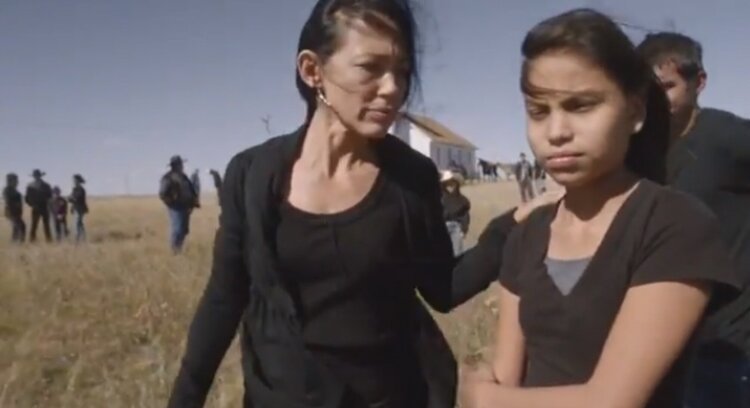Forms of Survival in Songs My Brother Taught Me
Songs My Brothers Taught Me, Chloé Zhao (2015)
The first note I made watching Songs My Brother Taught Me, Chloé Zhao's tender, beautiful debut feature, was "DW Griffith." And then an awkward pang: how could I invoke Griffith, a byword for the white supremacist roots of narrative cinema, alongside this sensitive tale of a beleaguered indigenous community? Two reasons. One: Griffith demanded that movies capture the "beauty of the wind in the trees." In Songs, the wind, alongside other forces that waver at the windows of imperceptibility, blows in campfires and among the mountainous plains. These images play a crucial role in communicating the vulnerability, openness, and neediness that are required for survival. Two: the model of neediness in Griffith's films follows an aggressively Darwinian Logic, whereby dependence is ultimately supplanted by the virtues of self-reliance, strength, and sovereignty. This is the worldview that Zhao explodes, with her vision of survival founded on a welcoming porousness.
At Lakota Pine Ridge Reservation in South Dakota old and new pains meet: decades of underinvestment and overpolicing coalesce with the memory of colonial pogroms against the Lakota people, most famously The Massacre of Wounded Knee. This vortex of neo-colonialism and neoliberalism has casualties: Pine Ridge regularly tops the country for unemployment, addiction, and suicide. State prohibition of alcohol exacerbates gang-violence and shrinks public space. Many of Songs' peripheral characters are alcoholics (past or present), including Jashaun and Johnny's mother. Johnny gets high with friends on the anniversary of their peer's suicide. Only Johnny's girlfriend, Aurelia, works in the formal economy. Johnny introduces the primacy of survival in the opening voiceover that describes "breaking" a horse: "Anything that runs wild got a bit of bad in there. You need to keep a bit of that. They need it to survive out here." This form of survival through domination opens, through the course of Songs, to a vista of absolute neediness.
At first blush, Johnny rejects mere survival or any logic of stasis. His girlfriend is going to college in California, and he's motivated by a desire to accompany her. Johnny needs a car and gas money, and his avenues for acquiring them are booze-bootlegging and (the pipedream of) professional boxing. During a career-guidance class, Johnny is woken up from a hangover-induced nap. He tells the teacher that he wants to be a boxer. There is, here, the juxtaposition of an aspiration for pure sovereignty and the fragility of the sleeping body. Later, we see Johnny shadow-boxing with his friends, ending the session with a look of confused anger. When he finally enters the ring, he is pummeled by a bigger fighter, eventually knocked down, with the crowd shouting "Get up! Get up!" The pursuit of this dream is fruitless. Likewise, Johnny's career as a bootlegger ends badly. He makes enough money to buy a car and escalate from selling out of his own home to visiting the homes of his patrons. But Johnny's itinerant entrepreneurialism has dire consequences: rival bootleggers beat him up and burn the car. This episode leaves Johnny bedridden, wincing as he smokes.
Jashaun's survival strategy is more oblique. She is, to an extent, given space to be a child. We first see her brushing her hands through fields of wheat and then playing with a dog. Jashaun's neediness is written into the performance: self-effacing, searching, sensitive. Before she speaks, she cries. The first sounds we hear Jashaun make are sobs when she visits the scorched land where her father died. Unlike Johnny, survival means preserving and strengthening life as it is, rather than finding a new one. She needs the emotional ballast of belonging—both to her ancestral community and to her paternal family. Jashaun's trajectory starts with needs being met, in a piecemeal sense, by her brother, who feeds and entertains her. She then moves towards an understanding that this source of care is necessary but insufficient, as she cultivates relationships with the wider family and with members of the community more rooted in Native American tradition.
Where is Jashaun looking? Her gaze disrupts the composition by drawing focus away from the moment of tenderness between mother and son, and the apparent wistfulness remains enigmatic; when the camera moves, it is away from whatever distracts her. Jashaun may be taken, like her hair, by the wind—or by the sweet mixture of wind and music. Zhao presents an intimate connection between the indigenous culture and the landscapes and weather of the Reservation. For the Oglala, the main Native American constituency on the Reservation, the land centers their worldview. To feel the wind is, then, to belong to a rich tradition. The emotional power of the song is indeterminate: it is a cowboy tune, but then cowboy culture—like bullfighting and rodeo—has been adopted by the Reservation. When the camera follows Jashaun's mother, she looks in the opposite direction. In a frame centered by a Christian church, it is appropriate that mother and daughter look towards different horizons: the mother who, like many on the Reservation, seeks salvation from her alcoholism through the church; the daughter who will seek salvation in the commune of her ancestral culture. There is a presentiment of the wish for rootedness in the Reservation traditions, and, more specifically, the longing for a richer community of care than her mother and brother.
In other words, Jashaun looks out towards her needs.
//
Essay by Sam Thompson
Guest Curator, Filmatique




